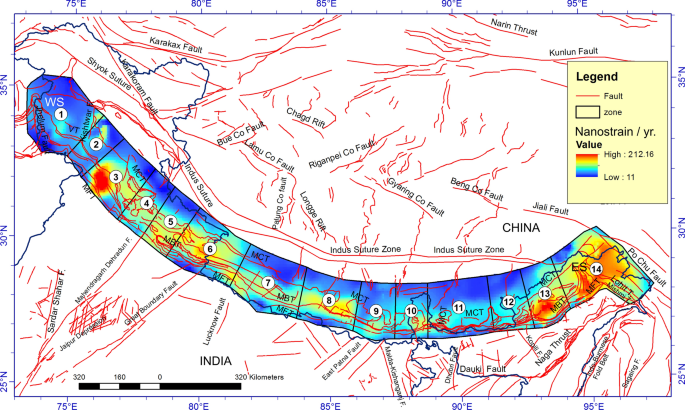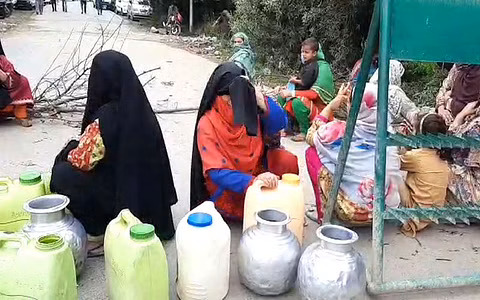Over View: Of the twenty member family, Kashmir Deer (Hangul) is the only asiatic survivor of this genus, since Shou or Sikkim stag is believed to have vanished from eastern Himalayas in Cumby valley of Sikkim, adjacent valleys of Bhutan and south eastern Nepal. Hangul being endemic to Jammu & Kashmir of a very poor population status was designated as State Animal in 1980’s to focus the attention of national and international organisations for its conservation. The deer once widely distributed in moist temperate forests of the state, is now confined to Dachigam and a few scattered isolated pockets within its distribution range.

Periodic Populations
Monitoring of Hangul in Dachigam has been in practice since early 20th century, but population statistics kept on fluctuating, which can be attributed to the enormity of anthropogenic pressures in the area and management interventions from time to time.
A decline to Dachigam Hangul population was observed when the estimated number of 3,000 to 5,000 recorded in early 1900’s dropped to 3,000 in 1947, which abruptly fall to 180 till 1965 and it became the Red Data Book Texan as a critically endangered species.
A gradual increase by 140 heads to the population of 320 was registered in seventies (1968-78), when it remained under the close observation of foreign experts and protection against incidences of poaching was strengthen. Sustained efforts of management helped to bring its periodic count to 900 to 1,000 in 1988. A comparative analysis of Hangul population in Dachigam from 1978-88 had shown an estimated increase of 60.88%, against 43.75% registered from 1968-78.
This increase accompanied by restocking in neighbouring forests by normal migration, led to upgrade Cheshmashahi Conservation Reserve in its south as national park in 1986 and renamed after Salim Ali. Protection was further extended to the summer habitat in north-east, east and south-east of upper Dachigam with status elevation of Thajwas (Baltal) Conservation Reserve and extension to Overa Conservation Reserve up to Kolhai with Cumbnai Conservation Reserve as a single management unit of Overa-Aru as wildlife sanctuaries in 1987. The status of Dachigam was too upgraded to national park in 1990. Paradoxically enough, the deer and its habitat received the best protection of all during 1980’s as such the Indian Board for Wildlife selected Dachigam to qualify for the best managed national park in India for the period of 1981 to 1984.
Turmoil in Kashmir deterred to monitor Hangul population in Dachigam from 1989-91, when it touched the lowest ebb of 140 to 160 in 1992 ever since recorded during the century. Later, the practice of Hangul enumeration continued unabated. It was estimated that Hangul range from 170 to 195 in Dachigam in 2003, while its over all statistics from 1994 to 2002 in Dachigam remained almost stable under prevailing looming threats.
The irregular count from 2004 on wards, with further perfection in the methodology, 2011 census was assessed to be 260 with the lower and upper ranges of 243 and 432 animals. Later, the 2013 Hangul population in Dachigam Landscape was estimated to be 279 animals, with the minimum and maximum range being 273 and 284 animals respectively.
2015 count indicated that Dachigam Hangul population has marked the lowest ever recorded number of 110 to 130. It’s over all population status in Dachigam and other relic populations in Kashmir range from 150 to 180; so at present the deer faces a precarious situation in the valley.
Conservation Measures
The International Union for Conservation of Nature and Natural Resources has listed Hangul as “Least concerned” by tagging it with the other red deer subspecies of the world. Meanwhile, phylogenetic analysis has linked Hangul with the Asian Tarim group. It is strongly recommended to upgrade Hangul conservation status under IUCN by desecrating it from the other subspecies of the world to draw more conservation attention from national and international organizations. It is listed under Schedule- I of the Indian Wildlife (Protection) Act, 1972 and Jammu & Kashmir Wildlife (Protection) Act, 1978 and has also been listed among the top fifteen species of high conservation priority by the Government of India. Whereas, every subspecies of Tiger has been assessed separately, the red deer subspecies have been lumped into a single conservation category of Least Concern under IUCN conservation status. However, our organisation is in constant touch with Cambridge University to list Kashmir stag as a critically endangered species.
Grazing
Indiscriminate grazing of state owned sheep in Dagwan valley and grazers (both non-local and local) in remaining upper Dachigam estimated 5,000 in 1978, exceeded to 60,000 heads till 2004, now extended further to lower Dachigam and has reportedly reached to 200,000 figure. Therefore a full-fledged settlement of illegal grazing is being encountered in Dachigam during summers, sparing hardly any space for the threatened deer in its last abode.
The shifting of Sheep Breeding and Research Centre in active consideration of the State Wildlife Advisory Board since its inception from 1978 was agreed by the State Cabinet, the order issued in 2005 in this regard has not yet to be implemented.
Other Forms of Land use Practices
Of 171.25 km² area of Dachigam merely 50 km² left for Hangul in lower Dachigam, which is further reduced by over 6 km² by various stakeholders by big staggered fenced areas in its prime winter habitat towards the western boundary owing to the other forms of land use practices.
In 1960’s over 1 km² excised from Mulnar, Dachigam for agriculture use under Grow More Food Program for dislocated families has changed now permanently into an illegal village and over 2.5 km² in Mahadav nar outlined and fenced for state owned Sheep Centre along south facing foot hill is the vital winter habitat for Hangul under hostile climatic conditions.
Near Dachigam nala Laribal Fish Farm, on opposite river bank bear enclosure with a cluster of buildings on vast land; besides near western boundary huge iron Rescue Centres extending up to southern foot hills all fenced and building of P H E Department near entrance have come up. In the southern foot hills opposite to the Farm, inspection huts at Panzgam have been come up.
Huge infrastructure for ecotourism in Corbett, Uttrakhand when hampered activities of Asiatic elephant was totally demolished by the management, which paved way for easy and free range movements of the metaphor species including others in the park.
Human Disturbances
Since the territorial control of the park vests with the Department of Wildlife Protection, but there are eleven state and central owned departments (J & K Police, Sheep Husbandry, Fisheries, Hospitality & Protocol, Gardens Parks & Floriculture, Irrigation & Flood Control, Public Health Engineering, Roads & Buildings, Power Development, Boarder Security Force & Bharat Sanchar Nigam, Ltd.) with their own set of activities in lower Dachigam right from the entry gates up to Pahlipora or at times even beyond. Number of employee’s stationed on permanent or temporary basis ranges from one to several dozens.
Magnitude of daily disturbance caused by the movement of employees though weakens beyond Laribal, but at times parties with big fleet of vehicles driving at top speed and sounding horns perpetually cause a great disturbance. Laborers engaged for maintenance and other purposes by most of the agencies that too in winters in prime Hangul habitat creates lot of disturbance through noise. According to Schaller (1969), matting behaviour is interrupted by workers. At present the study showed clear differences in the activity patterns of rutting stags, between the disturbed main valley and the parallel Badin nala, where human interference is almost absent (Kurt, 1978).
Regular interference of grazers, other forms of land use practices, besides, resources exploitation and severe human interferences have gained momentum with the passage of time, apparently seems quite lethal for the deer including other fauna and flora. Continuous and high magnitude of disturbance in Dachigam has presently fragmented Dachigam Hangul population, thus the present status of Hangul in Dachigam is of precarious nature and likely to face a serious threat of elimination through inbreeding.





